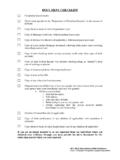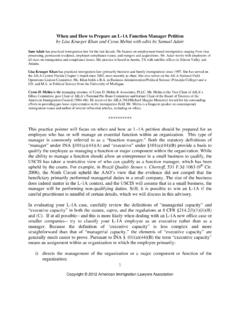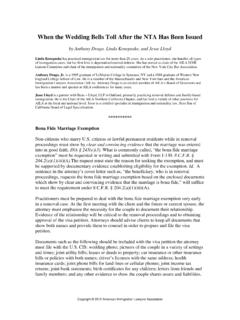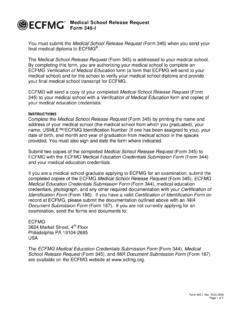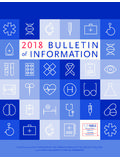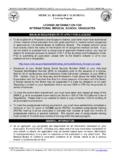Transcription of Clinical J-1 Waivers—A Primer - AILA webCLE
1 Copyright 2009, American Immigration Lawyers Association. Reprinted, with permission, from Immigration & Nationality Law Handbook (2009 10 Edition), available from AILA Publications, 1-800-982-2839, Clinical J-1 WAIVERS A Primer . by Benjamin T. Kurten, Jennifer A. Minear, and Elahe Najfabadi . According to the Educational Commission for Foreign Medical Graduates (ECFMG), more than 6,000 for- eign medical graduates applied for J-1 sponsorship to begin or extend participation in Clinical residency or fellowship training in the United States in 2007 08. 1 All foreign physicians who receive graduate medical training in J-1 nonimmigrant status must either return to their home country or country of last residence for an aggregate of two years, or obtain a waiver of that requirement before becoming eligible to: (1) apply for an immigrant visa; (2) adjust status; (3) apply for an H or L nonimmigrant visa; 2 or (4) change to almost any other nonimmigrant status within the United States. 3 While many J-1 physicians choose to return home at the completion of their J-1 education or training, those who prefer to remain in the United States indefinitely must obtain a waiver of the two-year foreign residency requirement.
2 A J-1 waiver may be granted on the basis of: (1) persecution the physician would suffer if the home residency requirement were enforced; (2) excep- tional hardship to a citizen or lawful permanent resident spouse or child if the requirement were en- forced; or (3) the physician's commitment to practice medicine in an underserved area of the United States for at least three years. 4. The vast majority of J-1 physicians who seek a waiver do so based on the recommendation of an Interested Government Agency (IGA) in exchange for the J-1 physician's commitment to practice full-time Clinical medi- cine for a period of at least three years in an area federally designated as a Health Professional Shortage Area (HPSA), Medically Underserved Area/Population (MUA/MUP), 5 or at a facility operated by the Department of . Benjamin T. Kurten is an attorney in the law firm of Quarles & Brady LLP in Milwaukee, a full-service corporate law firm. His practice is wholly concentrated in the area of immigration law, and particularly in business immigration, with a large num- ber of his clients from the healthcare industry.
3 He has been practicing law since 1997. Jennifer A. Minear is a senior associate attorney with McCandlish Holton, in Richmond, VA, where her business im- migration practice focuses largely on the representation of physicians and their employers. A cum laude graduate of Cornell Law School, Jennifer is a frequent panelist on national CLE teleconferences regarding the representation of foreign medical graduates, and has been named among the Legal Elite in the practice of immigration law by Virginia Business magazine. Elahe Najfabadi is a senior attorney with the Law Offices of Carl Shusterman in Los Angeles. Her area of practice includes representing health care professionals, outstanding professors and researchers, professional skateboarders, and persons in a wide variety of occupations in the IT industry. She was admitted to the California bar in 1991. 1. See The Educational Commission of Foreign Medical Graduates (ECFMG) administers the Department of State's (DOS) J-1 visa program for foreign medical graduates participating in graduate medical training, education, or advanced research at accredited facilities within the United States.
4 ECFMG is respon- sible for ensuring that all J-1 physicians and sponsoring facilities comply with the federal regulations governing program par- ticipation and for verifying the academic credentials and qualifications of foreign medical graduates in the J-1 program. 2. INA 212(e). 3. INA 248(a)(3). Note: Nonimmigrants subject to INA 212(e) are permitted to change status to A, G, U, or T nonimmigrant classification without first having to returned home for two years or obtained a J-1 waiver. INA 212(e)-subject nonimmigrants seeking other nonimmigrant status (O-1, F-1, B-1/B-2, etc.) must first depart the United States and re-enter using the new clas- sification. This is possible with all visa classifications except H and L. 4. INA 212(e). Note: Unlike other J-1 visa holders, a J-1 physician may not use the home country government's lack of objec- tion as a basis for granting the waiver. 5. Health Professional Shortage Areas (HPSAs) and Mental Health Professional Shortage Areas (MHPSAs) are geographic ar- eas, population groups, or specific facilities that are determined to have insufficient physician-to-patient population ratios.
5 Medically Underserved Areas/Medically Underserved Populations (MUA/MUP) are similar except that designation is based on a broader range of factors, including infant mortality and the percentage of poor/elderly patients, in addition to the physician- to-patient ratios. All federal shortage area determinations are made by the Health Resources and Services Administration within the Department of Health and Human Services. See 611. Copyright 2009 American Immigration Lawyers Association 612 IMMIGRATION & NATIONALITY LAW HANDBOOK, 2009 10. Veterans Affairs (VA facility). 6 This article will discuss the mechanics of applying for an IGA waiver, the poli- cies and procedures of the various state and federal agencies that agree to act as IGAs, and important strategy considerations when representing foreign physicians and their employers during the waiver process. NUTS AND BOLTS. As the J-1 physician nears completion of residency or fellowship training, he or she must begin to seek job offers that will qualify for an IGA Clinical waiver.
6 Depending on where the position is located, there may be only one suitable IGA, or several that could agree to support the physician's J-1 waiver application. The at- torney must have a good working knowledge of all federal or state IGAs that might have jurisdiction over the employment location, and assess the IGA's program requirements in conjunction with the physician's back- ground and employer's needs, in order to properly advise the physician and/or the potential employer of the appropriate J-1 waiver processing options. Once the physician has committed to a qualifying offer of employment, the convoluted J-1 waiver applica- tion process begins. The application must wend its way through three different agencies: the IGA, the Department of State (DOS), and the Citizenship and Immigration Services (USCIS). The first step is applying for a case number with DOS by submitting Form DS-3035, J-1 Visa Waiver Recommendation Application. The physician or the attorney must apply online and mail the signed original application form, filing fee, copies of passport information pages, J-1 visa stamp, I-94 card, DS-2019 forms, and signed original G-28 Notice of Entry of Appearance as Attorney or Representative to the DOS processing center in St.
7 Louis, MO. 7 DOS will not complete its processing of a J-1 waiver application until this step has been taken, so it is recommended that practitioners file the electronic and hard copies of the DS-3035 as early as possible in the waiver process. Next, the physician and the sponsoring employer submit all required documentation to the IGA, following the IGA's specific guidelines and procedures. The IGA then reviews the application and (hopefully) agrees to grant a favorable recommendation in support of the J-1 waiver request. Depending on the IGA, this process can take anywhere from a few weeks to many months. Once the IGA recommends the J-1 waiver, the entire application and IGA recommendation letter are forwarded to the DOS Waiver Review Division (WRD) in Washington, , for review and recommendation. While WRD almost always endorses the IGA's recom- mendation, 8 it occasionally requests additional documentation before doing so. This process can take any- where from four to eight weeks (sometimes less), after which WRD issues its own recommendation letter and sends the entire filing to the USCIS Vermont Service Center, which has exclusive jurisdiction over all J-1.
8 Waiver applications recommended by an IGA. USCIS then generates the formal J-1 waiver approval notice, typically within no more than two to three weeks. The J-1 waiver approval covers both the J-1 principal as well as accompanying J-2 dependents. 9. Federal regulations require the J-1 physician to complete the J-1 waiver commitment in H-1B nonimmigrant status. 10 The practitioner should, therefore, take the H-1B requirements into account during the J-1 waiver proc- ess to avoid delays later. For example, the salary offered in the J-1 waiver employment contract should comply with wage and hour regulations governing H-1B employees, and the physician should be sure to obtain all documentation required for the H-1B petition, including a medical license in the state where he or she will serve his or her waiver commitment, as far in advance as possible so that the H-1B petition can be submitted in a timely fashion. 11 In this regard, it is important to note that the sponsoring employer may file an H-1B petition on 6.
9 INA 214(l). There can be an exception to the requirement to practice in a federally designated underserved location when the IGA is a state department of health. This exception will be discussed in detail below. 7. See 8. 22 CFR (e)(4); 22 CFR (c)(5). 9. 8 CFR (c)(9)(i). 10. 8 CFR (c)(9)(iii). 11. For regulations pertaining to H-1B petitions filed on behalf of foreign physicians, see 8 CFR (h)(4(viii). Copyright 2009 American Immigration Lawyers Association Clinical J-1 WAIVERS A Primer 613. the physician's behalf as soon as WRD issues its recommendation. 12 USCIS will then process the H-1B petition and J-1 waiver approval notice simultaneously. This can be of great benefit to the physician whose J-1 status is about to expire and may need to file a change of status petition to H-1B before USCIS issues the formal ap- proval notice. 13 Another tremendous benefit to the J-1 waiver physician is the fact that all physicians who have been approved for a J-1 Clinical IGA waiver are exempt from the statutory H-1B cap.)
10 14 This permits the phy- sician to commence employment with the waiver sponsoring employer without regard to the numerical restric- tions pertaining to other H-1B petitions. The cap exemption is personal to the physician and applies regardless of the nature of the health care facility or organization sponsoring the J-1 waiver. 15. As one might imagine, processing times for J-1 waiver applications are very unpredictable and can be af- fected by a host of factors. In general, it is best for the physician to begin the waiver application process at least eight to nine months in advance of his or her desired start date, depending on which IGA is sponsoring the waiver. STATE VS. FEDERAL INTERESTED GOVERNMENT AGENCIES. Every state department of health has the authority to sponsor up to 30 J-1 visa waiver physicians per fiscal year. 16 In addition, federal agencies may agree to sponsor an unlimited number of J-1 physicians for IGA. Clinical waivers. 17 Under the statute, any federal agency may choose to serve as an IGA for a J-1 Clinical phy- sician.

